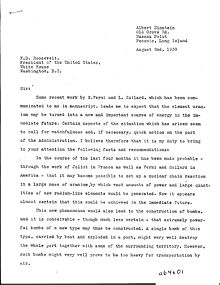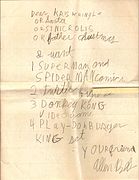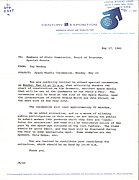Letter (message)

A letter is a written message conveyed from one person (or group of people) to another through a medium. [1] The term usually excludes written material intended to be read in its original form by large numbers of people, such as newspapers and placards, although even these may include material in the form of an "open letter". The typical form of a letter for many centuries, and the archetypal concept even today, is a sheet (or several sheets) of paper that is sent to a correspondent through a postal system. Letters can be formal or informal. Besides being a means of communication and a store of information, letter writing has played a role in the reproduction of writing as an art throughout history.[1] Letters have been sent since antiquity and are mentioned in the Iliad.[2] Historians Herodotus and Thucydides mention and use letters in their writings.[3]
History of letter writing[]



Historically, letters have existed from, ancient India, ancient Egypt and Sumer, through Rome, Greece and China, up to the present day. During the 17th and 18th centuries, letters were used to self-educate.[clarification needed] The main purposes of letters were to send information, news and greetings. For some, letters were a way to practice critical reading, self-expressive writing, polemical writing and also exchange ideas with like-minded others. For some people, letters were seen as a written performance.[clarification needed] Letters make up several of the books of the Bible. Archives of correspondence, whether for personal, diplomatic, or business reasons, serve as primary sources for historians. At certain times, the writing of letters was thought to be an art form and a genre of literature, for instance in Byzantine epistolography.[4]
In the ancient world letters might be written on various different materials, including metal, lead, wax-coated wooden tablets, pottery fragments, animal skin, and papyrus. From Ovid, we learn that Acontius used an apple for his letter to Cydippe.[5] More recently, letters have mainly been written on paper: handwritten and more recently typed.
Letters were a chief form of communication, in both personal and business communication, for many centuries before telegraphy, telephony, and internet communications reduced their primacy. Even in times and places where literacy was lower, illiterate people could pay literate ones to write letters to, and to read letters from, distant correspondents. Even in the era of telegrams and telephones, letters remained quite important until fax and email further eroded their primacy, especially since the turn of the 21st century. As communication technology has developed in recent history, posted letters on paper have become less important as a routine form of communication. For example, the development of the telegraph drastically shortened the time taken to send a communication, by sending it between distant points as an electrical signal. At the telegraph office closest to the destination, the signal was converted back into writing on paper and delivered to the recipient. The next step was the telex which avoided the need for local delivery. Then followed the fax (facsimile) machine: a letter could be transferred from the sender to the receiver through the telephone network as an image. These technologies did not displace physical letters as the primary route for communication; however today, the internet, by means of email, plays the main role in written communications, together with text messages; however, these email communications are not generally referred to as letters but rather as e-mail (or email) messages, messages or simply emails or e-mails, with the term "letter" generally being reserved for communications on paper.
As literary historical source material[]
Due to the timelessness and universality of letter writing, there is a wealth of letters and instructional materials (for example, manuals, as in the medieval ars dictaminis) on letter writing throughout history. The study of letter writing usually involves both the study of rhetoric and grammar.[6]
Comparison with electronic mail[]

Despite email, letters are still popular, particularly in business and for official communications. At the same time, many "letters" are sent in electronic form. The following advantages of paper letters over e-mails and text messages are put forward:
- No special device is needed to receive a letter, just a postal address, and the letter can be read immediately on receipt.
- An e-mail may sit in a recipient's inbox for some time before being read, or may not be read at all; a paper letter is more likely to receive prompt attention once it arrives.
- An advertising mailing can reach every address in a particular area.
- A letter provides an immediate, and in principle permanent, physical record of communication, without the need for printing. Letters, especially those with a signature and/or on an organization's own notepaper, are more difficult to falsify than is an email, and thus provide much better evidence of the contents of the communication.
- A letter in the sender's own handwriting is more personal than an e-mail and shows that the sender has taken trouble to write it.
- If required, small physical objects can be enclosed in the envelope with the letter.
- Letters are unable to transmit malware or other harmful files that can be transmitted by e-mail.
- E-mails are insecure and may be intercepted en route. For this reason, letters are often preferred for confidential correspondence.
- Letter writing leads to the mastery of the technique of good writing.
- Letter writing can provide an extension of the face-to-face therapeutic encounter.[clarification needed][7]
The following advantages are put forward for e-mails and text messages over traditional letters:
- Potentially they can be transmitted instantly.
- They can be sent to a number of recipients in one operation (this is also a disadvantage as it leads to needless time-consuming correspondence).
- They do not require postage to be paid (although there is often a small fee for sending a text message).
- They do not require materials such as paper and ink.
- Often an e-mail would require a less formal style than a letter to the same recipient, and thus may take less time to write. It is also easier to make amendments to a draft than it is with a handwritten letter.
- E-mails may be composed using spell checkers and other devices, and thus may conceal the ignorance (inability to spell or compose prose etc.) of the sender; this may be an advantage or a disadvantage.
- During an epidemic, e-mails cannot transmit diseases.
- They don't take up physical space and can't be damaged in a natural disaster.
Delivery process[]
Here is how a letter gets from the sender to the recipient:
- Sender composes and writes letter and may fold the letter so that it fits in an envelope. For bulk mailings, a folding machine may be employed.
- Sender places the letter in an envelope on which the recipient's address is written on the front of the envelope, or often is visible through a transparent window of the envelope. Sender ensures that the recipient's address includes the Zip or Postal Code (if applicable) and historically often included his/her return address on the envelope.
- For small volume private letters, the sender buys a postage stamp and attaches it to the top right corner on the front of the envelope. (For most commercial letters, postage stamps are not used: a franking machine or other methods are used to pay for postage.)
- Sender puts the letter in a postbox.
- The national postal service of the sender's country (e.g. Royal Mail, UK; USPS, United States; Australia Post in Australia; or Canada Post in Canada) empties the postbox and transports all the contents to the local sorting office.
- The sorting office then sorts each letter by address and postcode and sends the letters destined for a particular area to that area's local sorting office (sometimes called a delivery office). Letters addressed to a different region may go through more than one stage of transmission and sorting.
- The local delivery personnel collect the letters from the delivery office and deliver them to the proper addresses. In some areas, recipients may need to collect the letters from the local office.
This process, depending on how far the sender is from the recipient, can take anywhere from a day to 3–4 weeks. International mail is sent via trains and airplanes to other countries.
In 2008, Janet Barrett in the UK received an RSVP to a party invitation addressed to 'Percy Bateman', from 'Buffy', allegedly originally posted on 29 November 1919. It had taken 89 years to be delivered by the Royal Mail.[8] However, Royal Mail denied this, saying that it would be impossible for a letter to have remained in their system for so long, as checks are carried out regularly. Instead, the letter dated 1919 may have "been a collector's item which was being sent in another envelope and somehow came free of the outer packaging".[9]
Forms of letters[]
The forms (conformations) of letters have usually followed traditional norms of the times and places where correspondence took place. Aspects such as where to place the elements (salutation, body of letter, valediction/closing, sender's address, recipient's address, date, and so on) were somewhat standardized albeit also usually flexible in practice. The form often varied by kind of letter. For any kind, though, factors of cost—such as that each sheet/leaf of paper cost money to buy and to post, and the fact of who paid for the posting (sender or recipient)—placed constraints on the forms of letters that varied from negligible in some times and places to crucial in others. These factors of cost drove norms on whether to write on both sides of the leaf, whether to cross the leaf with lines written in both directions (horizontally and vertically), whether to allow margins and how big or small to make them, how much to abbreviate to save space, and whether to have a separate envelope and thus how to fold the letter and where on the leaf to put the addresses.
Business encyclopedias and textbooks of the 19th and 20th centuries show that businesspeople of those eras sometimes took the standardization of the forms of business letters to extremes. Typists were required to follow dozens or hundreds of rules about element placement and sizing, some of them with rather arbitrary and even counterproductive (wastefully expensive) strictness. However, the effort to standardize (on where to put the information and how to represent it) did have various valid motivations, as in some respects it presaged the concept of data normalization, helping with the extensive manual indexing, cataloguing, and filing that characterized the clerking duties of the era.
Cryptography sometimes played a role in letters in centuries past, as correspondents would use previously agreed code to try to shield the plaintext from the comprehension of prying eyes during the letter's transit. This could be done in business letters to lessen spying by competitors on prices and methods and in personal letters to try to evade postal censorship (either of wartime censors or of peacetime authoritarian censors) or the gossip of townsfolk. It could be in either cryptic form (for example, "AEDFX GHSTR HTFXV") or in deceptively readable form (for example, "the dog will run at sunset unless the rains come"). By the standards of modern digital applied cryptography, the security was often not especially high (that is, the codebreaking was not necessarily difficult), but it was usually high enough to meet the demands of the context (that is, the degree of risk and the likelihood or stakes of any codebreaking efforts).
Over the centuries, a lexicon of abbreviations, metonymic short forms, and conventional valedictions developed for frequent use in letters. For example, "yours of the 12th inst." meant "your letter of the 12th of this month"; "do" meant "ditto"; and forms like "Yr Obdt Srvt" for "Your Obedient Servant" were common.
Kinds of letters[]
There are a number of different types of letter:
- Audio letter
- Business letter
- Cease and desist letter
- Chain letter
- Cover letter
- Crossed letter
- Dear John letter
- Epistle
- Form letter
- Hate mail
- Hybrid mail (semi-electronic delivery)
- Informal letter
- Formal letter
- Letter of credence
- Letter of intent
- Letter of introduction
- Letter of marque
- Letter of resignation
- Letter of thanks
- Letter to the editor
- Letters patent
- Love letter
- National Letter of Intent
- Open letter
- Poison pen letter
- Query letter
- Recommendation letter and the closely related employment reference letter
- Sales letter
Gallery[]

By writing both across and down, the sender of a letter could save on postage.

A hand-written letter of Cesare Borgia.

A child's letter to Santa Claus.

A letter from Arthur Conan Doyle about The Hound of the Baskervilles.

An invitation letter to the ground-breaking of the Seattle Space Needle, 1961.

The resignation letter of Richard Nixon, 1974.

A letter sheet. - The Letter, 1873
Means of transport[]
- Address
- Avis de réception
- Envelope
- Letter box
- Letter collection
- Manuscript
- Message in a bottle
- Pen pal
- Proof of delivery
- Return receipt
- Salutation
- Secrecy of letters
- Snail mail
- Valediction
References[]
- ^ Jump up to: a b Blake, Gary; Bly, Robert W. (1993). The Elements of Technical Writing. . p. 125. ISBN 0020130856.
- ^ Homer, Iliad, 6. 167–70.
- ^ Ebbeler, J. (2009). "Tradition, Innovation, and Epistolary Mores". In Rousseau, P. (ed.). A Companion to Late Antiquity. Chichester: Wiley-Blackwell. p. 270. ISBN 978-1-4051-1980-1.
- ^ "Epistolography" in The Oxford Dictionary of Byzantium, Oxford University Press, New York & Oxford, 1991, p. 718. ISBN 0195046528
- ^ Ovid, Her. 20
- ^ Carol Poster and Linda C. Mitchell, eds., Letter-Writing Manuals and Instruction from Antiquity to the Present (Columbia, SC: U of South Carolina Press, 2007).
- ^ [1]
- ^ Glenday, Craig (2013). Guinness Book of World Records 2014. pp. 127. ISBN 978-1-908843-15-9.
- ^ "Royal Mail delivers letter 89 years late". The Daily Telegraph. 8 December 2008. Archived from the original on 13 April 2017. Retrieved 13 April 2017.
External links[]
| Wikimedia Commons has media related to Letters (written messages). |
| Wikisource has original text related to this article: |
 The dictionary definition of letter at Wiktionary
The dictionary definition of letter at Wiktionary- Letters as historical sources.
- The First English Family Letters at History Today
- Letters (message)
- Paper products
- Postal system






